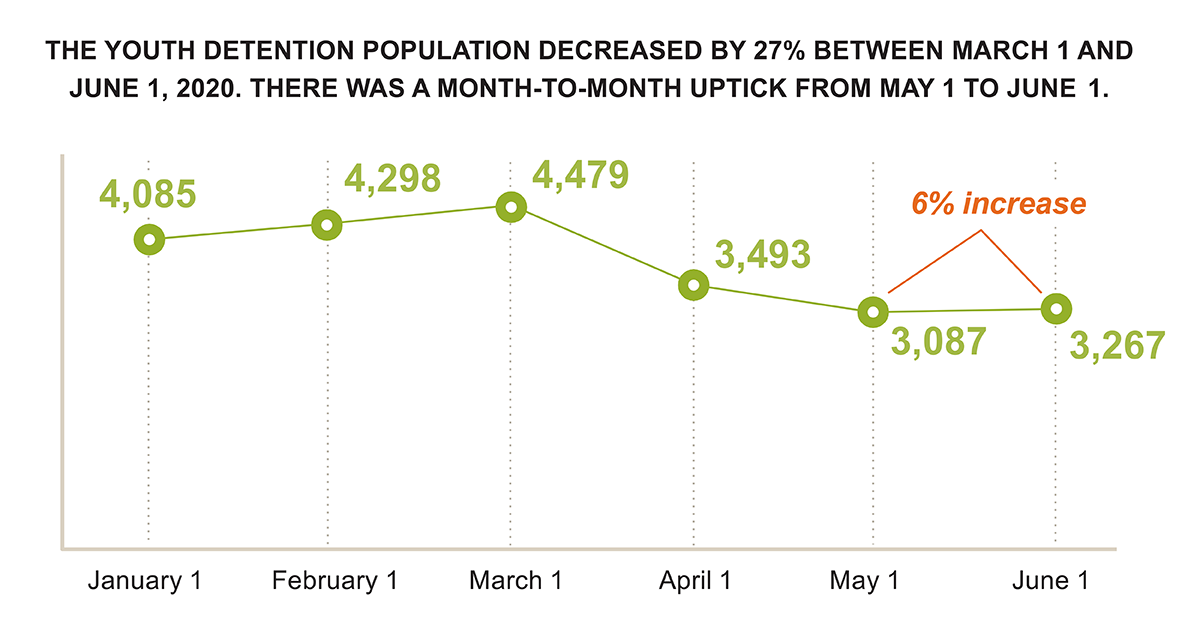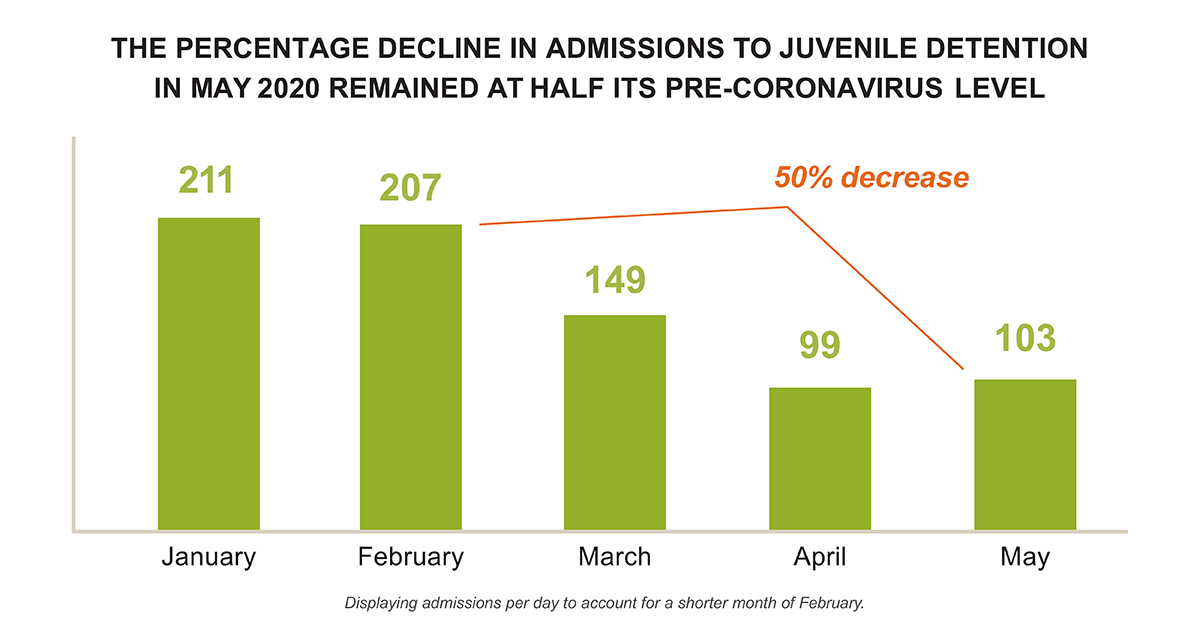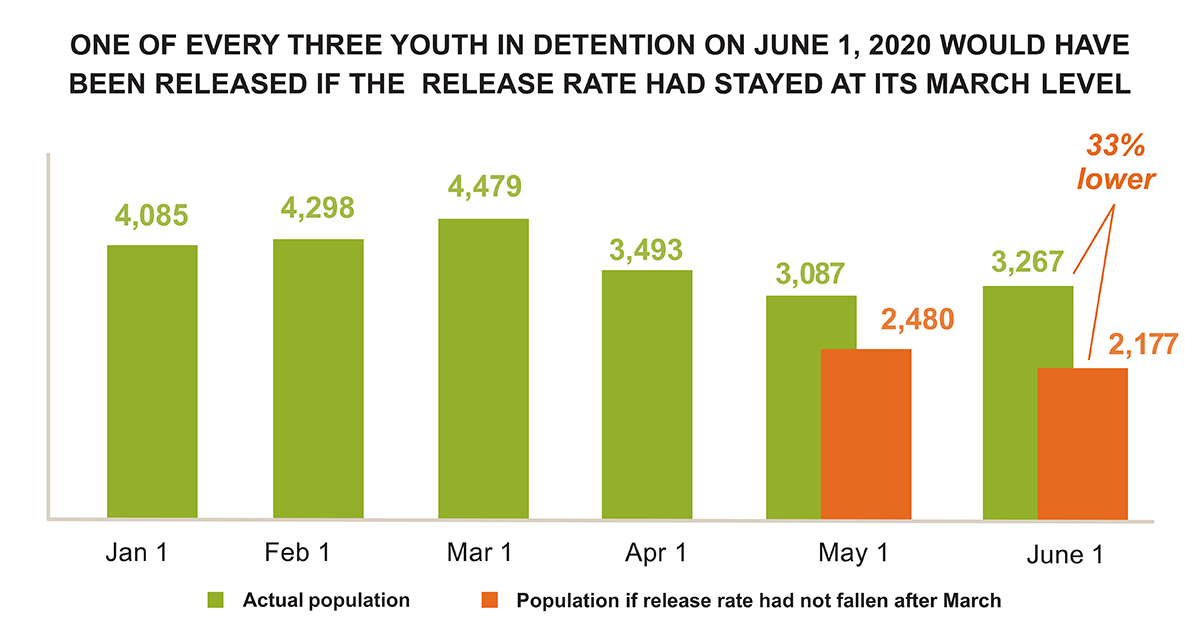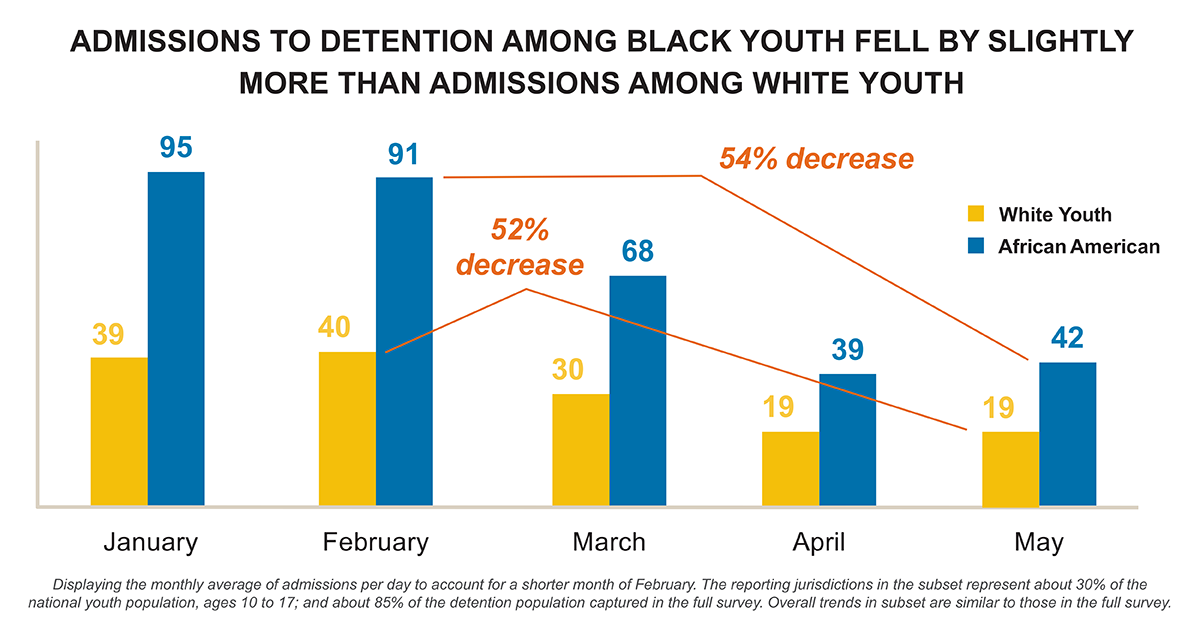Youth Detention Admissions Remain Low, But Releases Stall Despite COVID-19
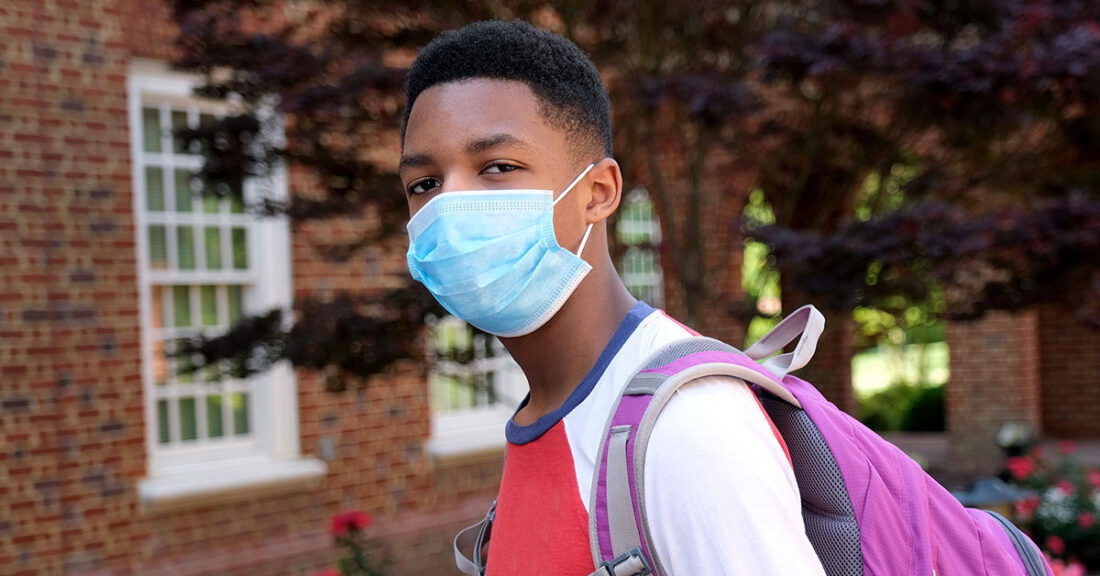
While admissions to youth detention continued to fall dramatically in the three months since the COVID-19 outbreak in March 2020, a new survey of juvenile justice agencies in 33 states shows that systems slowed the pace of releasing young people from detention, leaving many young people — disproportionately Black — still living in confinement without access to opportunities or connections, and potentially vulnerable to the virus.
After a surge of releases in March, young people were less likely to be released from detention in April and May than they were before the pandemic started, the latest data collected by the survey showed. Overall, the dramatic decline in admissions has reduced the youth detention population by 27% since the pandemic began, but the population grew slightly in May. One of every three young people in detention on June 1 would not have been in detention if the release rate had stayed at its March level.
In the months since the pandemic emerged in March, the disparities in detention that disadvantage Black youth have gotten worse, solely because Black youth have been released at a slower rate than their white peers. While admissions among Black youth actually fell a bit more than admissions among white youth, Black youth continued to be overrepresented in detention because the widening gap in the release rate is larger than any gains on the admissions side.
“These data demonstrate how critical it is for juvenile justice systems not only to keep young people out of detention facilities but also to act with urgency to get young people out,” says Nate Balis, director of the Annie E. Casey Foundation’s Juvenile Justice Strategy Group. “A more equitable youth justice system requires intense focus on releasing Black youth from detention.”
A slower release rate means youth are staying in detention longer. The dangers of confinement were well known before the pandemic. The additional risk of COVID-19 transmission should make accelerating releases the priority for youth justice systems with respect to their use of secure detention.
These trends are reflected in an Annie E. Casey Foundation survey of jurisdictions around the country aimed at assessing the effects of the pandemic on juvenile justice systems through June 1, 2020. Working with the Pretrial Justice Institute and Empact Solutions, the Foundation first collected data just weeks after the coronavirus arrived in the United States.
The jurisdictions responding to the latest survey are home to 35% of the U.S. youth population, ages 10 to 17. Most of the responding communities are involved in the Juvenile Detention Alternatives Initiative® (JDAI), a network of juvenile justice practitioners and other system stakeholders across the country working to build a better and more equitable youth justice system.
The Role of Detention Centers in Juvenile Justice
Detention centers are different than youth prisons or other residential placements where young people could be sentenced after being adjudicated delinquent. Rather, detention is a crucial early phase in the juvenile justice process. It’s the point at which the courts decide whether to confine a young person pending their court hearing or while awaiting placement into a correctional or treatment facility rather than allowing the young person to remain at home.
Every year, an estimated 218,000 young people spend time in detention facilities nationwide, despite the negative effects of detention on young people and persistent racial disparities in who is detained.
Key Findings From the Juvenile Justice Survey
The survey findings include the following:
Secure detention populations, which had been falling since March, increased slightly in May due to too few releases of young people from detention, not an influx of new admissions.
On June 1, 2020, the number of young people in detention was 27% below its pre-crisis level but no longer falling month to month. If the population strictly followed the path of admissions, the population would be lower than it is. But while the rate of admissions was plummeting, the release rate decreased as well. As a result, the population increased 6% between May 1 and June 1.
The decrease in population was driven primarily by a steep decline in the rate of admissions.
In February, jurisdictions reported an average of 207 admissions per day. But in April and May the average was around 100 admissions per day ― half the pre-pandemic rate.
Juvenile justice systems had increasing difficulty releasing young people who were detained.
The release rate is the percentage of all young people who were in detention at any point during a month who were released before the end of that month. The higher the release rate, the shorter stays in detention are on average. If the release rate is dropping, as it was in April and May, then young people are staying longer. By May, the rate had slowed by 22% compared to its March high.
One of every three young people in detention on June 1, 2020, would not have been in detention if the release rate had stayed at its March level.
Had the release rate in April and May 2020 stayed at the March rate of 62%, then dramatically fewer young people would have been held in detention on June 1, 2020. The actual population as of June 1 was 3,267. It would have been one-third lower, just 2,177, if the March rate were maintained.
Disparities in admissions improved for African American youth when the juvenile justice system had a smaller footprint.
Among jurisdictions that provided information disaggregated by race and ethnicity, only about one-fifth of detained young people are white, while more than half are African American and nearly one-fourth are Latino. Over the first three months of the pandemic, admissions to juvenile detention have fallen somewhat proportionally by race: 54% for Black youth, 52% for white youth and 51% for Latino youth. But given that youth of color were overrepresented to start with, in absolute terms 78% of the decline in admissions was among youth of color.
Disparities in release rates that disadvantage Black youth grew, which led to lower overall population declines for Black youth than for white youth.
White youth in detention continued to be more likely to be released than African American youth. Before COVID-19, the white release rate was about 7% higher than the African American release rate. By May 2020 it was 17% higher, meaning the gap had more than doubled in size. The widening gap meant white youth experienced a larger population drop than African American youth despite African American gains in admissions. The population decline between March 1 and June 1 was 30% for white youth and 27% for African American youth.
Most jurisdictions reported no cases of COVID-19 as of June
At the time of the survey in June, 66% of the jurisdictions responding said that they had access to information about COVID-19 cases among youth and staff in detention facilities. Among those with access to that information, the vast majority (85%) reported no confirmed or suspected COVID-19 cases among their staff or youth.
Among the 15% that did, jurisdictions identified a total of 26 confirmed or suspected youth cases, and another 52 recovered youth, as of the date they completed the survey in June. The survey was not designed to calculate COVID-19 prevalence rates for individual facilities, but among jurisdictions reporting any youth cases, the number of confirmed or suspected youth cases was about 6% of their combined populations as of June 1. Among staff, 55 confirmed or suspected cases and another 106 recovered cases were reported across 15 jurisdictions.
About the survey
This survey, conducted from June 10 to 17 and covering the period from January 1 to June 1, is unique because it reports on data from hundreds of jurisdictions in close to real time. Information came from large urban counties and small rural courts, among a wide range of jurisdictions that collectively held 4,479 young people in secure detention on March 1, 2020. For perspective, approximately 15,660 young people were held in detention nationally on any given night, according to the most recent federal data from 2017.
There are no direct points of comparison that place this three-month reduction in context. Available data on detention utilization from national surveys indicate that significant changes in detention typically accrue over several years.
This is a non-random sample, so it is not an accurate source from which to derive national estimates or determine statistically how representative this group of jurisdictions is of the nation as a whole. While there is overlap, the pool of jurisdictions replying to a monthly survey is unique to that survey alone, so monthly results cannot be directly compared. All of the data are self-reported by the participating jurisdictions.
Find a set of questions that can help juvenile justice leaders reduce youth detention




